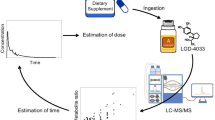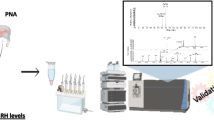Abstract
The applicability of a mass spectrometry (MS)-based method for determination of various forms of human chorionic gonadotropin (hCG) in doping analysis was demonstrated. A clinical study involving the hCG-containing pharmaceuticals Pregnyl and Ovitrelle was carried out, comprising a single injection of one pharmaceutical per participant to a total of 24 healthy male voluntaries. Hereafter, serum and urine samples were collected over a period of 14 days. The analysis of the samples using immuno-MS demonstrated elimination profiles of intact hCG for both pharmaceuticals, with last day of detection following administration at day 7 in serum, and at day 10 in urine, at limit of detections as defined by the World Anti-Doping Agency. Furthermore, the method allowed detection and differentiation of the various forms of hCG known to be present in serum and urine as a function of metabolism. For both pharmaceuticals, only the intact hCG was detected in serum, whereas in urine the injection of Pregnyl as hCG source (containing urinary hCG, i.e., most hCG variants) was shown to generate a more complex hCG variant pattern compared to Ovitrelle (contains only intact hCG). By detecting hCG using this MS-based approach in doping analysis, strong analytical evidence is provided minimizing the risk of false-positive and false-negative results.


Similar content being viewed by others
References
Stenman U-H, Tiitinen A, Alfthan H, Valmu L (2006) The classification, functions and clinical use of different isoforms of HCG. Hum Reprod Update 12(6):769–784. doi:10.1093/humupd/dml029
Handelsman DJ (2006) The rationale for banning human chorionic gonadotropin and estrogen blockers in sport. J Clin Endocrinol Metab 91(5):1646–1653. doi:10.1210/jc.2005-2569
World Anti-Doping Agency (2012) The 2012 Prohibited List. Retrieved 25 Sept from http://www.wada-ama.org/Documents/World_Anti-Doping_Program/WADP-Prohibited-list/2012/WADA_Prohibited_List_2012_EN.pdf
Kicman AT, Brooks RV, Cowan DA (1991) Human chorionic gonadotropin and sport. Br J Sports Med 25:73–80
Stenman UH, Hotakainen K, Alfthan H (2008) Gonadotropins in doping: pharmacological basis and detection of illicit use. Br J Pharmacol 154(3):569–583
World Anti-Doping Agency (2011) Guidelines: reporting and management of human chorionic gonadotropin (hCG) findings (version 1.0 September 2011):1–8. Retrieved 25 Sept from http://www.wada-ama.org/Documents/Resources/Guidelines/WADA_Guidelines_Reporting_Management_hCG_findings_v1.0_EN.pdf
Bagshawe KD (2000) Limitations of tests for human chorionic gonadotropin. Lancet 355(9205):671
Berger P, Sturgeon C, Bidart JM, Paus E, Gerth R, Niang M, Bristow A, Birken S, Stenman UH (2002) The ISOBM TD-7 workshop on hCG and related molecules—towards user-oriented standardization of pregnancy and tumor diagnosis: assignment of epitopes to the three-dimensional structure of diagnostically and commercially relevant monoclonal antibodies directed against human chorionic gonadotropin and derivatives. Tumor Biol 23(1):1–38
Cole LA (2009) Human chorionic gonadotropin tests. Expert Rev Mol Diagn 9(7):721–747. doi:doi:10.1586/erm.09.51
Cole LA, Sutton JM, Higgins TN, Cembrowski GS (2004) Between-method variation in human chorionic gonadotropin test results. Clin Chem 50(5):874–882. doi:10.1373/clinchem.2003.026989
Sturgeon CM, Berger P, Bidart J-M, Birken S, Burns C, Norman RJ, Stenman U-H, on behalf of the IFCC Working Group on hCG (2009) Differences in recognition of the 1st WHO international reference reagents for hCG-related isoforms by diagnostic immunoassays for human chorionic gonadotropin. Clin Chem 55(8):1484–1491. doi:10.1373/clinchem.2009.124578
Hemmersbach P (2008) History of mass spectrometry at the Olympic Games. J Mass Spectrom 43(7):839–853
Barroso O, Handelsman DJ, Strasburger C, Thevis M (2012) Analytical challenges in the detection of peptide hormones for anti-doping purposes. Bioanalysis 4(13):1577–1590. doi:10.4155/bio.12.128
Thevis M, Thomas A, Schänzer W (2011) Current role of LC-MS(/MS) in doping control. Anal Bioanal Chem 401(2):405–420. doi:10.1007/s00216-011-4859-9
Lund H, Løvsletten K, Paus E, Halvorsen TG, Reubsaet L (2012) Immuno MS-based targeted proteomics: highly specific, sensitive and reproducible hCG determination for clinical diagnostics and doping analysis. Anal Chem. doi:10.1021/ac301418f
Lund H, Torsetnes SB, Paus E, Nustad K, Lo R, Halvorsen TG (2009) Exploring the complementary selectivity of immunocapture and MS detection for the differentiation between hCG isoforms in clinically relevant samples. J Proteome Res 8(11):5241–5252
Norwegian Medicines Agency (2011) Preparatsøk. Preparatomtale. Retrieved 25 Sept from http://www.legemiddelverket.no/custom/Preparatsok/prepSearch____80333.aspx
Rowland M, Tozer TN (2011) Clinical pharmacokinetics and pharmacodynamics. 4th edn. Lippincott, Williams & Wilkins, Philadelphia
Gam L-H, Tham S-Y, Latiff A (2003) Immunoaffinity extraction and tandem mass spectrometric analysis of human chorionic gonadotropin in doping analysis. J Chromatogr B 792(2):187–196
Stenman U-H, Unkila-Kallio L, Korhonen J, Alfthan H (1997) Immunoprocedures for detecting human chorionic gonadotropin: clinical aspects and doping control. Clin Chem 43(7):1293–1298
Handelsman DJ, Goebel C, Idan A, Jimenez M, Trout G, Kazlauskas R (2009) Effects of recombinant human LH and hCG on serum and urine LH and androgens in men. Clin Endocrin 71(3):417–428. doi:10.1111/j.1365-2265.2008.03516.x
Lempiäinen A, Hotakainen K, Alfthan H, Stenman U-H (2012) Loss of human chorionic gonadotropin in urine during storage at −20 °C. Clin Chim Acta 413(1–2):232–236. doi:10.1016/j.cca.2011.09.038
Robinson N, Sottas P-E, Saugy M (2010) Evaluation of two immunoassays for the measurement of human chorionic gonadotropin in urine for anti-doping purposes. Clin Lab 56(5–6):197–206
Cole L (2009) New discoveries on the biology and detection of human chorionic gonadotropin. Reprod Biol Endocrin 7(1):8
Acknowledgment
This project has been carried out with the support of WADA.
Ethics approval
The project has been assessed and approved by the Norwegian Regional Committee for Medical Research Ethics.
Author contributions
The manuscript was written through contributions of all authors. All authors have given approval to the final version of the manuscript.
Funding sources
This project has received funding from WADA.
Author information
Authors and Affiliations
Corresponding author
Rights and permissions
About this article
Cite this article
Lund, H., Snilsberg, A.H., Paus, E. et al. Sports drug testing using immuno-MS: clinical study comprising administration of human chorionic gonadotropin to males. Anal Bioanal Chem 405, 1569–1576 (2013). https://doi.org/10.1007/s00216-012-6566-6
Received:
Revised:
Accepted:
Published:
Issue Date:
DOI: https://doi.org/10.1007/s00216-012-6566-6




